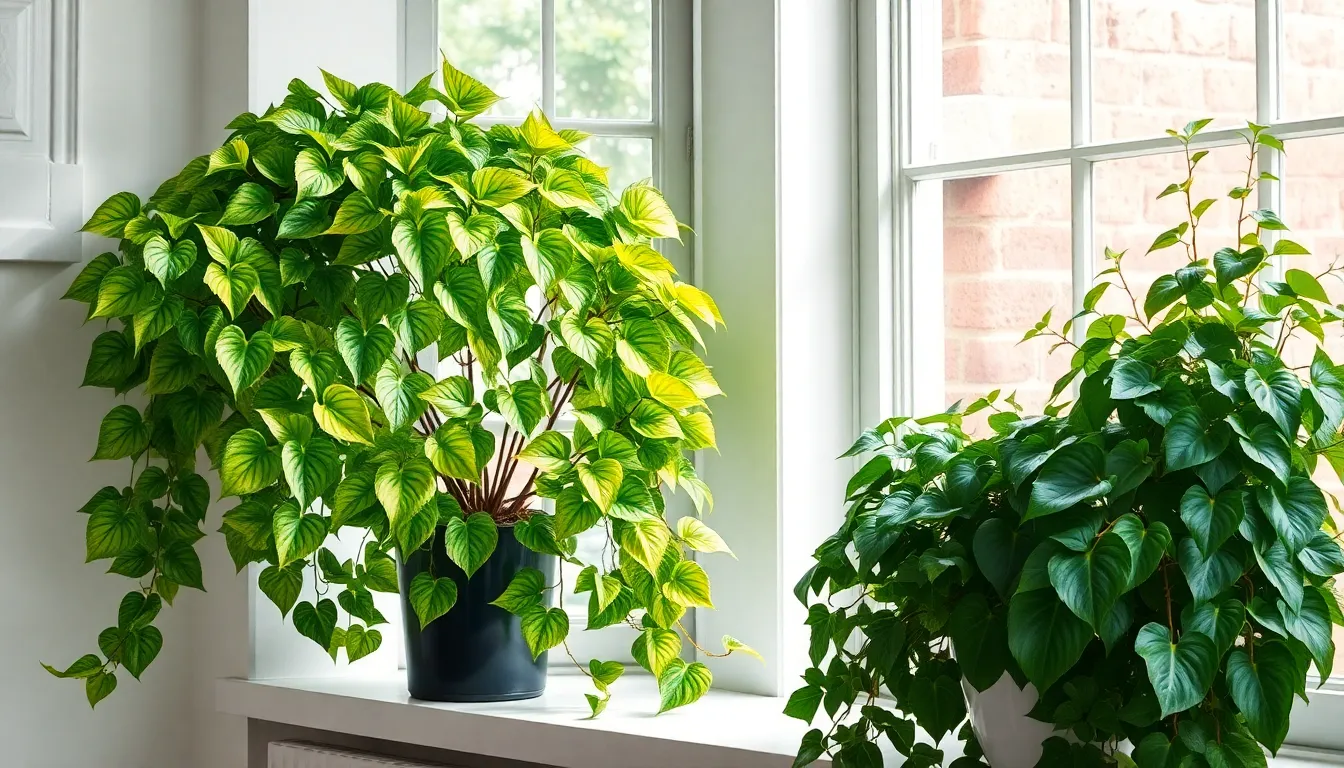Ivy plants are the ultimate indoor companions, bringing a touch of nature right into your living room. Not only do they add a splash of greenery, but they also have a knack for making any space feel more inviting. Picture this: you walk into your home, and instead of a dull corner, you’re greeted by a lush cascade of ivy. Instant mood booster, right?
ivy plants indoor
Ivy plants offer numerous advantages when kept indoors. Their benefits extend beyond mere decoration, significantly enhancing living spaces.
Air Quality Improvement
Ivy plants actively purify air by absorbing toxins. They effectively filter pollutants like formaldehyde and benzene, promoting healthier indoor environments. Studies indicate that ivy reduces airborne mold and bacteria, leading to improved respiratory health. Individuals with asthma or allergies may notice relief due to these qualities. Incorporating ivy into homes can create cleaner air, positively impacting overall well-being.
Aesthetic Appeal
Ivy plants contribute visually striking elements to any room. Their trailing vines and lush foliage add dimension and texture, making spaces feel more inviting. Adaptable to various décor styles, ivy complements contemporary and traditional settings alike. By strategically placing ivy in corners or on shelves, homeowners can create natural focal points. With minimal care, ivy maintains its beauty, allowing individuals to enjoy vibrant green accents year-round.
Types Of Ivy Plants For Indoor Use

Ivy plants offer a variety of selections for indoor use, each bringing unique characteristics and benefits. Below are two popular types of ivy suitable for indoor environments.
English Ivy
English Ivy, known for its adaptability, thrives in low-light conditions. This plant features striking green and variegated leaves that enhance visual appeal. It grows rapidly and can be trained to climb or cascade, making it versatile for various spaces. English Ivy effectively purifies indoor air, filtering harmful toxins like benzene and formaldehyde. Caring for English Ivy involves keeping the soil moist and providing moderate sunlight. Regular pruning encourages bushier growth, maintaining a vibrant appearance throughout the year.
Algerian Ivy
Algerian Ivy, also recognized as Hedera canariensis, stands out with its large, heart-shaped leaves. This type prefers bright, indirect sunlight and can tolerate lower light levels. Algerian Ivy exhibits fast growth, creating a lush, green backdrop for various indoor settings. Its resilience against common pests makes it an excellent choice for indoor gardeners. When caring for Algerian Ivy, ensure the soil remains slightly damp and avoid overwatering. This plant adds a tropical feel to interiors, promoting a relaxing atmosphere.
Caring For Ivy Plants Indoor
Caring for indoor ivy plants ensures vibrant growth and longevity. Providing the right conditions promotes their health and beauty.
Light Requirements
Ivy plants thrive in bright, indirect light. They adapt well to low-light conditions as well. Excessive direct sunlight may scorch the leaves. English Ivy does particularly well in moderate light settings. Algerian Ivy prefers bright, filtered light to flourish. Assessing the light levels helps to position ivy plants correctly. Check for signs of distress, such as leggy growth, indicating insufficient light. Proper lighting significantly affects growth rates and overall plant health.
Watering Guidelines
Maintaining appropriate moisture levels is crucial for ivy plants. Soil should stay consistently moist but never soggy. Overwatering can lead to root rot, causing serious harm. Check the soil’s top inch; if dry, it’s time to water. During the growing season, water more frequently; reduce frequency in fall and winter. English Ivy enjoys regular hydration, while Algerian Ivy benefits from slightly drier conditions between waterings. Observing the leaves helps identify watering needs—droopy leaves signal thirst, while yellowing leaves indicate overwatering.
Fertilization Tips
Fertilizing ivy plants supports their growth and vitality. Use a balanced, water-soluble fertilizer every month during the growing season. Diluting the fertilizer helps prevent concentration damage. Ivy doesn’t require much feeding in fall and winter. Choose a fertilizer formulated for houseplants for best results. Adjust the feeding schedule based on the plant’s response—prominent growth indicates satisfaction. Regular fertilization enhances foliage color and encourages lush growth, creating an inviting indoor atmosphere.
Common Issues With Indoor Ivy Plants
Indoor ivy plants may encounter several challenges affecting their health and appearance. Understanding these common issues helps ensure the plants thrive in their environment.
Pests and Diseases
Indoor ivy faces threats from various pests and diseases. Aphids, spider mites, and mealybugs often infest leaves, sucking vital nutrients. Regular inspections help catch these pests early. Treatments like insecticidal soap can effectively eliminate infestations. Fungal infections can also arise, particularly if humidity levels are too high or ventilation is poor. Keeping air circulating and ensuring leaves stay dry reduces the risk of fungal issues. Identifying symptoms early, such as yellowing leaves or wilting, allows for quick intervention.
Proper Pruning Techniques
Pruning maintains the vitality and shape of ivy plants. Regular cutting encourages new growth and keeps the plant from becoming leggy. Shearing back vines after new growth appears promotes bushier foliage. Using sharp, clean scissors ensures smooth cuts; this minimizes damage to the plant. Removing dead or yellowing leaves improves overall appearance and health. Pruning during the spring or early summer supports optimal growth. Regular attention to pruning techniques helps create a fuller, healthier ivy display indoors.
Conclusion
Ivy plants make a remarkable addition to any indoor space. Their ability to purify air while enhancing aesthetic appeal is truly unmatched. With minimal care requirements and adaptability to various light conditions, these plants can thrive in diverse environments.
Homeowners can enjoy the vibrant greenery and soothing atmosphere ivy provides. By selecting the right type and following proper care techniques, anyone can cultivate a thriving indoor garden. Embracing ivy not only beautifies a home but also promotes a healthier living space for everyone.

